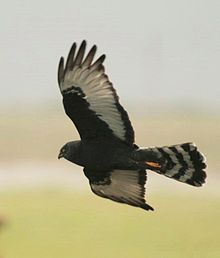Black harrier
| Black harrier | |
|---|---|

| |
| Scientific classification | |
| Domain: | Eukaryota |
| Kingdom: | Animalia |
| Phylum: | Chordata |
| Class: | Aves |
| Order: | Accipitriformes |
| Family: | Accipitridae |
| Genus: | Circus |
| Species: | C. maurus
|
| Binomial name | |
| Circus maurus Temminck, 1828
| |

| |
| distribution | |
The black harrier (Circus maurus) is a medium-sized African harrier whose range extends from South Africa to Botswana and Namibia.
It has a wingspan of 105–115 cm (41–45 in) and a body length of 44–50 cm (17–20 in).[2]
When perched, this bird appears all black. However, in flight a white rump and flight feathers become visible. Its morphology is comparable to that of other harriers, with a slim body, narrow wings and a long tail. Male and female plumages are similar. Juveniles have buff under-parts and heavily spotted breasts.
Like other harriers it nests on the ground in tall vegetation. Three to five eggs are laid and incubated 35 days.
It feeds mostly on small rodents and birds and will occasionally take reptiles, catching them while flying low over its hunting grounds. Variation in diet is thought to be associated with local weather conditions. Inland, during hot temperatures the proportion of small mammals in the harrier's diet declines, whilst in coastal regions the proportion of small mammals in the diet increased with higher winter rainfall.[3]
The greatest number of breeding pairs can be found in the Western Cape province, South Africa. In this area loose colonies aggregate around coastal wetlands. Breeding in Namibia is suspected but not confirmed.
The black harrier population has declined in recent years to fewer than 1000 birds, and it is now classified as vulnerable, despite still having a wide breeding range. This is due to the destruction of its original breeding habitat, South Africa's natural shrubland, the fynbos, which has been greatly reduced by encroaching cereal culture and urban expansion.
References
- ^ Template:IUCN
- ^ Kemp, A.C.; Kirwan, G.M.; Christie, D.A. (2013). del Hoyo, J.; Elliott, A.; Sargatal, J.; Christie, D.A.; de Juana, E. (eds.). "Black Harrier (Circus maurus)". Handbook of the Birds of the World Alive. Barcelona, Spain: Lynx Edicions. Retrieved 7 December 2015.
- ^ Garcia-Heras, M.-S.; Mougeot, F.; Simmons, R. E.; Arroyo, B. (2017). "Regional and temporal variation in diet and provisioning rates suggest weather limits prey availability for an endangered raptor". Ibis. 159 (1): 567–579. doi:10.1111/ibi.12478.
External links
- Black Harrier - Species text in The Atlas of Southern African Birds
- BirdLife Species Factsheet
- Black Harrier videos on the Internet Bird Collection
- Black Harrier at Raptors Namibia
- Black harrier photos at Fernkloof Nature Reserve

